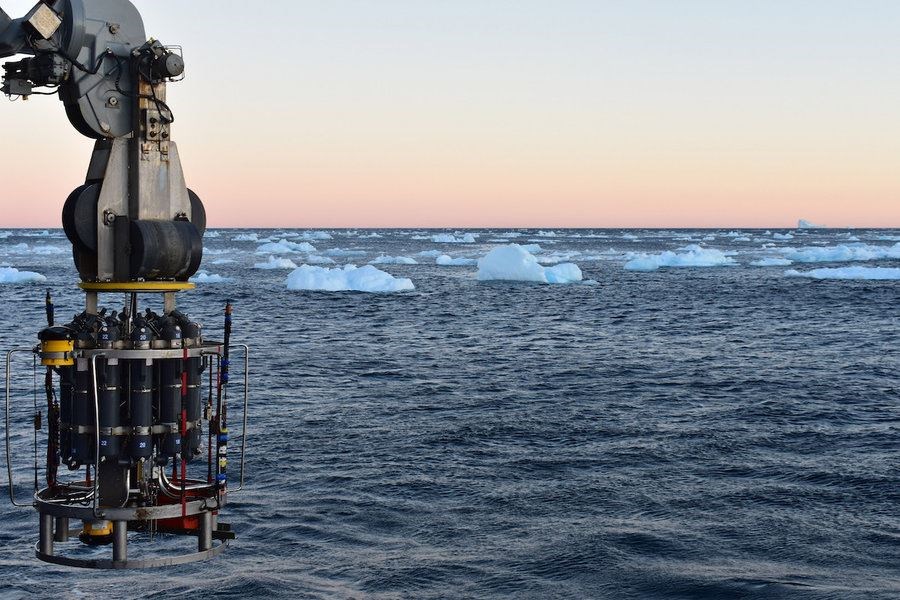Reprinted with permission from The Christian Science Monitor
Scientists have found that a section of the Atlantic Ocean previously considered an "engine" of the world’s climate is actually hundreds of miles in another direction. Understanding ocean circulation offers critical insights into its affects on droughts and the frequency of hurricanes.
WASHINGTON - One of the key drivers of the world's climate is an area in the North Atlantic Ocean where warmer and colder water mix and swirl. When scientists went for their first close look at this critical underwater dynamo, they found they were looking in the wrong place.
 A probe that collects water samples and measures temperature, salinity, and pressure is prepared for deployment on the continental shelf of Greenland in September 2018. Scientists were studying the Atlantic Meridional Overturning Circulation (AMOC), a circulation of warm and cold waters tht stretches from around Greenland south to beyond the tip of Africa and into the Indian Ocean.Isabela Le Bras/AP
A probe that collects water samples and measures temperature, salinity, and pressure is prepared for deployment on the continental shelf of Greenland in September 2018. Scientists were studying the Atlantic Meridional Overturning Circulation (AMOC), a circulation of warm and cold waters tht stretches from around Greenland south to beyond the tip of Africa and into the Indian Ocean.Isabela Le Bras/AP
By hundreds of miles.
The consequences are not quite yet understood, but eventually it could change forecasts of one of the worst-case global warming scenarios – still considered unlikely this century – in which the mixing stops and climate chaos ensues.
It's called the Atlantic Meridional Overturning Circulation, and scientists describe it as a giant ocean conveyor belt that moves water from Greenland south to beyond the tip of Africa and into the Indian Ocean.
Warm, salty water near the surface moves north and mixes with cold, fresher water near Greenland. As that water cools and sinks it drives a slow circulation of the oceans that is critical to global climate, affecting the location of droughts and frequency of hurricanes. It also stores heat-trapping carbon dioxide deep in the ocean. The faster it moves, the more warm water gets sent into the depths to cool.
The area where warm water turns over in the North Atlantic is considered to be the engine of the conveyor belt. Scientists thought it was in the Labrador Sea west of Greenland.
But then a new international science team measured temperature, saltiness and the speed of ocean currents throughout the North Atlantic to try to better understand the conveyor belt. The preliminary results after hundreds of measurements in 21 months found that engine was several hundreds of miles east of where they figured, said study lead author Susan Lozier, an ocean sciences professor at Duke University. The study, published in Thursday's journal Science, puts it east of Greenland, closer to Scotland.
The computer simulations that predict how the climate could change in coming years didn't factor in exactly where the conveyor belt engine is, and now they may be able to. Ms. Lozier and several outside experts said this doesn't change their trust in the models, especially because when the models are checked with what is happening in the real world, they are found to be generally accurate.
"It doesn't mean that the models are all wrong at all," said Tom Delworth, a senior scientist at the National Oceanic and Atmospheric Administration's geophysical lab in Princeton, N.J.
Massachusetts Institute of Technology's Carl Wunsch and other outside experts said the study was helpful, but pointed out that 21 months of study is not enough to know if this different location is temporary or permanent.
Scientists have long feared that the conveyor belt could be slowing and, in a worst-case scenario, could even stop and cause abrupt and catastrophic climate change. It is considered a potential climate tipping point that was the premise of the scientifically inaccurate 2004 disaster movie "The Day After Tomorrow."
Based on computer model studies, the United Nations' Intergovernmental Panel on Climate Change reported in an earlier study it is "very unlikely" that the conveyor belt would collapse this century. But the Nobel Prize-winning scientific panel concluded it is likely to get about a third slower if greenhouse gas emissions continue at its current pace.
A study last year found that global warming is weakening the system, saying the conveyor belt was moving at its slowest speed in nearly 140 years of records.
"Our basic understanding that the collapse is unlikely still stands," said Mr. Delworth, who wasn't part of the study. "Our uncertainty about that prediction is high."
This story was reported by The Associated Press.
Page created on 2/5/2019 3:50:57 AM
Last edited 2/5/2019 4:24:41 AM
